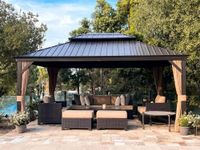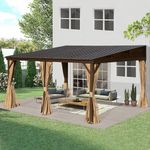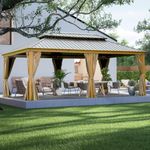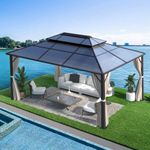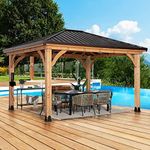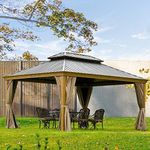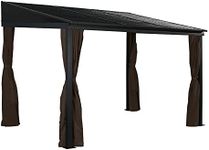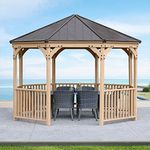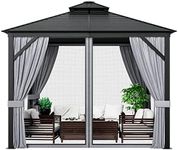Buying Guide for the Best Hardtop Gazebos
Choosing a hardtop gazebo is a great way to add a stylish and functional outdoor space to your backyard, patio, or garden. When shopping for a hardtop gazebo, it's important to consider how you plan to use it—whether for entertaining, relaxing, dining, or providing shelter from the elements. Understanding the key features and specifications will help you find a gazebo that fits your needs, space, and style preferences. Take your time to compare options, think about your climate, and consider how much maintenance you're willing to do.Size and DimensionsThe size and dimensions of a hardtop gazebo refer to its length, width, and height. This is important because it determines how much space the gazebo will take up in your yard and how many people or pieces of furniture it can accommodate. Gazebos come in a range of sizes, from compact models suitable for small patios to large structures that can host big gatherings. To choose the right size, measure your available space and think about how you plan to use the gazebo—smaller sizes are great for intimate seating or hot tubs, while larger ones are better for dining sets or parties.
Roof MaterialThe roof material of a hardtop gazebo is a key factor in its durability, weather resistance, and appearance. Common materials include polycarbonate panels, galvanized steel, and aluminum. Polycarbonate is lightweight and lets in some light, but may not be as strong as metal. Steel roofs are very sturdy and offer excellent protection from sun, rain, and snow, but can be heavier. Aluminum is rust-resistant and lighter than steel, making it easier to assemble. Consider your local weather—if you get heavy snow or rain, a strong metal roof is best; for milder climates, polycarbonate may be sufficient.
Frame MaterialThe frame material affects the gazebo's strength, longevity, and maintenance needs. Most hardtop gazebos use powder-coated steel or aluminum frames. Steel frames are strong and stable, ideal for windy areas, but can rust if not properly coated. Aluminum frames are lighter and naturally resistant to rust, making them easier to move and maintain. If you want a low-maintenance option, aluminum is a good choice; if you need extra sturdiness, look for a well-coated steel frame.
Ventilation and AirflowVentilation refers to how well air can circulate inside the gazebo, which is important for comfort, especially in hot weather. Some hardtop gazebos have a double-tiered roof or built-in vents that allow hot air to escape and fresh air to flow in. This helps keep the space cooler and reduces wind resistance. If you live in a hot or humid area, or plan to use the gazebo for grilling or gatherings, look for models with good ventilation features.
Mosquito Netting and CurtainsMany hardtop gazebos come with optional mosquito netting or privacy curtains. Netting keeps bugs out, making the space more comfortable in the evenings, while curtains provide shade and privacy. Some gazebos include these features, while others offer them as add-ons. If you want to use your gazebo at night or value privacy, choose a model with these accessories or make sure they can be added later.
Anchoring and StabilityAnchoring refers to how the gazebo is secured to the ground, which is crucial for safety and stability, especially in windy conditions. Some gazebos come with anchor kits or pre-drilled holes for bolts, while others may require additional hardware. Consider your surface—concrete, deck, or grass—and make sure the gazebo can be properly anchored. If you live in a windy area, prioritize models with strong anchoring options.
Assembly and MaintenanceAssembly describes how easy or difficult it is to put the gazebo together, and maintenance refers to the care needed to keep it in good shape. Some gazebos are designed for easy DIY assembly with clear instructions, while others may require more time or extra hands. Maintenance needs depend on the materials—metal roofs and frames may need occasional cleaning and rust checks, while polycarbonate panels may need to be washed. If you prefer minimal upkeep, look for rust-resistant materials and simple designs.
